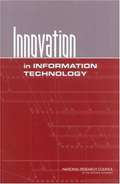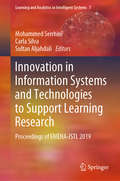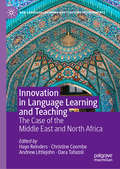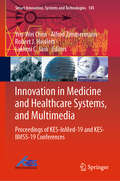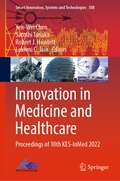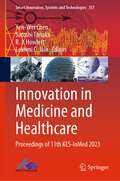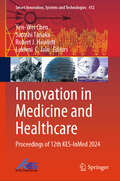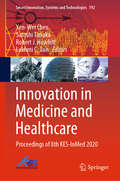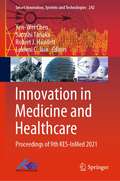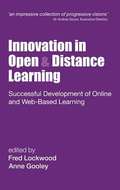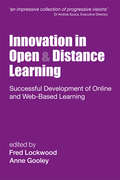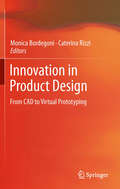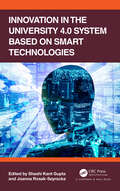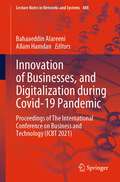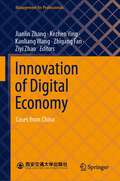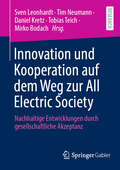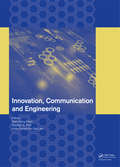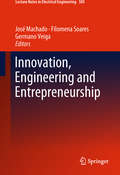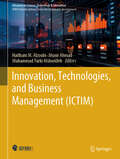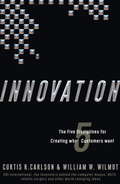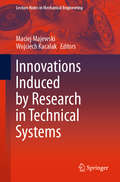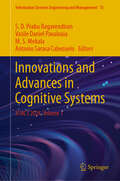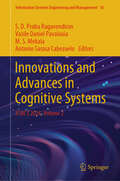- Table View
- List View
Innovation in INFORMATION TECHNOLOGY
by Telecommunications Board Computer ScienceA report on the Innovation in Information Technology
Innovation in Information Systems and Technologies to Support Learning Research: Proceedings of EMENA-ISTL 2019 (Learning and Analytics in Intelligent Systems #7)
by Mohammed Serrhini Carla Silva Sultan AljahdaliThis book provides glimpses into contemporary research in information systems & technology, learning, artificial intelligence (AI), machine learning, and security and how it applies to the real world, but the ideas presented also span the domains of telehealth, computer vision, the role and use of mobile devices, brain–computer interfaces, virtual reality, language and image processing and big data analytics and applications. Great research arises from asking pertinent research questions. This book reveals some of the authors’ “beautiful questions” and how they develop the subsequent “what if” and “how” questions, offering readers food for thought and whetting their appetite for further research by the same authors.
Innovation in Language Learning and Teaching: The Case of the Middle East and North Africa (New Language Learning and Teaching Environments)
by Christine Coombe Hayo Reinders Andrew Littlejohn Dara TafazoliThis edited collection presents a study of innovation in teaching, learning, assessment and teacher development practices in the Middle East and North Africa (MENA). The thirteen research-based chapters in this collection examine recent innovations in English language teaching, drawing on classroom, administrative and learning experiences from seven of the countries in the region. The major trends analyzed across the volume include the language skills of reading and writing and the prevalence of technology and technology-enhanced instruction. It highlights that innovative teaching, learning and assessment practices that are now in place in virtually all levels of English language teaching and learning from primary school to university to adult education sectors, and reflects on possible ways forward for innovation in the field of ELT. This book will provide valuable insight for scholars of applied linguistics and practitioners working in language policy,
Innovation in Language Teaching and Learning: The Case of Japan (New Language Learning and Teaching Environments)
by Stephen Ryan Hayo Reinders Sachiko NakamuraThis book examines a wide range of innovations in language learning and teaching in Japan. Each of the chapters describes the impetus for a change or new development in a particular context, from early childhood to adult learning, details its implementation and provides an evaluation of its success. In doing so, they provide a comprehensive overview of best practice in innovating language education from teaching practice in formal classroom settings, to self-directed learning beyond the classroom, and offer recommendations to enhance language education in Japan and beyond. The book will be of interest to scholars of applied linguistics and language development, and in particular to those involved in managing change in language education that attempts to mediate between global trends and local needs.
Innovation in Medicine and Healthcare Systems, and Multimedia: Proceedings of KES-InMed-19 and KES-IIMSS-19 Conferences (Smart Innovation, Systems and Technologies #145)
by Lakhmi C. Jain Robert J. Howlett Yen-Wei Chen Alfred ZimmermannThis book contains the proceedings of the KES International conferences on Innovation in Medicine and Healthcare (KES-InMed-19) and Intelligent Interactive Multimedia Systems and Services (KES-IIMSS-19), held on 17–19 June 2019 and co-located in St. Julians, on the island of Malta, as part of the KES Smart Digital Futures 2019 multi-theme conference.The major areas covered by KES-InMed-19 include: Digital IT Architecture in Healthcare; Advanced ICT for Medical and Healthcare; Biomedical Engineering, Trends, Research and Technologies and Healthcare Support System. The major areas covered by KES-IIMSS-19 were: Interactive Technologies; Artificial Intelligence and Data Analytics; Intelligent Services and Architectures and Applications. This book is of use to researchers in these vibrant areas, managers, industrialists and anyone wishing to gain an overview of the latest research in these fields.
Innovation in Medicine and Healthcare: Proceedings of 10th KES-InMed 2022 (Smart Innovation, Systems and Technologies #308)
by Lakhmi C. Jain Robert J. Howlett Yen-Wei Chen Satoshi TanakaThis book presents the proceedings of the KES International Conferences on Innovation in Medicine and Healthcare (KES-InMed-22), held in Rhodes, Greece, on June 20–22, 2022. Covering a number of key areas, including digital IT architecture in health care; advanced ICT for medicine and health care; biomedical engineering, trends, research, and technologies; and healthcare support systems, this book is a valuable resource for researchers, managers, industrialists, and anyone wishing to gain an overview of the latest research in these fields.
Innovation in Medicine and Healthcare: Proceedings of 11th KES-InMed 2023 (Smart Innovation, Systems and Technologies #357)
by Lakhmi C. Jain Yen-Wei Chen Satoshi Tanaka R. J. HowlettThis book presents the proceedings of the KES International Conferences on Innovation in Medicine and Healthcare (KES-InMed-23), held in Rome, Italy, on June 14–16, 2023. Covering a number of key areas, including digital IT architecture in healthcare; advanced ICT for medicine and healthcare; biomedical engineering, trends, research and technologies; and healthcare support systems, this book is a valuable resource for researchers, managers, industrialists and anyone wishing to gain an overview of the latest research in these fields.
Innovation in Medicine and Healthcare: Proceedings of 12th KES-InMed 2024 (Smart Innovation, Systems and Technologies #412)
by Lakhmi C. Jain Robert J. Howlett Yen-Wei Chen Satoshi TanakaThis book presents the proceedings of the KES International Conferences on Innovation in Medicine and Healthcare (KES-InMed-24), held in Madeira, Portugal, on June 19–21, 2024. Covering a number of key areas, including digital IT architecture in healthcare; advanced ICT for medicine and healthcare; biomedical engineering, trends, research, and technologies; and healthcare support systems, this book is a valuable resource for researchers, managers, industrialists, and anyone wishing to gain an overview of the latest research in these fields.
Innovation in Medicine and Healthcare: Proceedings of 8th KES-InMed 2020 (Smart Innovation, Systems and Technologies #192)
by Lakhmi C. Jain Robert J. Howlett Yen-Wei Chen Satoshi TanakaThis book presents the proceedings of the KES International Conferences on Innovation in Medicine and Healthcare (KES-InMed-19), held in Split, Croatia, on June 17–19, 2020. Covering a number of key areas, including digital IT architecture in healthcare; advanced ICT for medicine and healthcare; biomedical engineering, trends, research and technologies; and healthcare support systems, this book is a valuable resource for researchers, managers, industrialists and anyone wishing to gain an overview of the latest research in these fields.
Innovation in Medicine and Healthcare: Proceedings of 9th KES-InMed 2021 (Smart Innovation, Systems and Technologies #242)
by Lakhmi C. Jain Robert J. Howlett Yen-Wei Chen Satoshi TanakaThis book presents the proceedings of the KES International Conferences on Innovation in Medicine and Healthcare (KES-InMed-21), held virtually on June 14–16, 2021. Covering a number of key areas, including digital IT architecture in healthcare; advanced ICT for medicine and healthcare; biomedical engineering, trends, research and technologies; and healthcare support systems, this book is a valuable resource for researchers, managers, industrialists and anyone wishing to gain an overview of the latest research in these fields.
Innovation in Open and Distance Learning: Successful Development of Online and Web-based Learning
by Fred Lockwood Anne GooleyOpen and distance education is now widespread, not just in the open universities of the world, but in all education and training sectors, from traditional campus universities to corporate training centers.With contributions from some of the world's leading practitioners in the field, this book draws together contemporary experience in the application of technology to distributed learning. It will be a valuable guide to all those implementing web-based learning. It provides a thought provoking appraisal of the strategies and processes for managing change in open and distance learning and offers a progressive vision for all those involved in this widespread discipline.
Innovation in Open and Distance Learning: Successful Development of Online and Web-based Learning (Open and Flexible Learning Series)
by Fred Lockwood Anne GooleyThis volume draws together experiences in the application of technology to distributed learning. It offers an appraisal of the strategies and processes for managing change in open and distance learning and presents a progressive vision for all those involved in this widespread discipline.
Innovation in Product Design
by Monica Bordegoni Caterina RizziInnovation in Product Design gives an overview of the research fields and achievements in the development of methods and tools for product design and innovation. It presents contributions from experts in many different fields covering a variety of research topics related to product development and innovation. Product lifecycle management, knowledge management, product customization, topological optimization, product virtualization, systematic innovation, virtual humans, design and engineering, and rapid prototyping are the key research areas described in the book. It also details successful case studies developed with industrial companies. Innovation in Product Design is written for academic researchers, graduate students and professionals in product development disciplines who are interested in understanding how novel methodologies and technologies can make the product development process more efficient.
Innovation in the University 4.0 System based on Smart Technologies
by Shashi Kant Gupta and Joanna Rosak-SzyrockaThis text presents a comprehensive analysis of mathematical formulations for proving the effectiveness of artificial intelligence in education and investigates the possibilities for integrating advanced artificial intelligence algorithms. The book:• presents an empirical analysis of the impact of information technology in the education system• discusses student performance in university 4.0 using novel artificial intelligence algorithm with whale optimization• elaborates the management of higher education based on information technology in the university 4.0 era• explains the implementation of university 4.0 based on artificial intelligence • focuses on the transformation of education system using artificial intelligence. The text is primarily written for graduate students, postgraduate students, and academic researchers working in the fields of computer science and engineering, information technology and machine learning.
Innovation of Businesses, and Digitalization during Covid-19 Pandemic: Proceedings of The International Conference on Business and Technology (ICBT 2021) (Lecture Notes in Networks and Systems #488)
by Allam Hamdan Bahaaeddin AlareeniThis book constitutes the refereed proceedings of the International Conference on Business and Technology (ICBT2021) organized by EuroMid Academy of Business & Technology (EMABT), held in Istanbul, between 06–07 November 2021. In response to the call for papers for ICBT2021, 485 papers were submitted for presentation and inclusion in the proceedings of the conference. After a careful blind refereeing process, 292 papers were selected for inclusion in the conference proceedings from forty countries. Each of these chapters was evaluated through an editorial board, and each chapter was passed through a double-blind peer-review process.The book highlights a range of topics in the fields of technology, entrepreneurship, business administration, accounting, and economics that can contribute to business development in countries, such as learning machines, artificial intelligence, big data, deep learning, game-based learning, management information system, accounting information system, knowledge management, entrepreneurship, and social enterprise, corporate social responsibility and sustainability, business policy and strategic management, international management and organizations, organizational behavior and HRM, operations management and logistics research, controversial issues in management and organizations, turnaround, corporate entrepreneurship, innovation, legal issues, business ethics, and firm gerial accounting and firm financial affairs, non-traditional research, and creative methodologies.These proceedings are reflecting quality research contributing theoretical and practical implications, for those who are wise to apply the technology within any business sector. It is our hope that the contribution of this book proceedings will be of the academic level which even decision-makers in the various economic and executive-level will get to appreciate.
Innovation of Digital Economy: Cases from China (Management for Professionals)
by Kanliang Wang Jianlin Zhang Kezhen Ying Zhigang Fan Ziyi ZhaoThis book presents a rich selection of 36 real-world cases on how organizations in China explore the new growth pattern, business model innovation, and digital transformation in digital era. The topic of cases varies from digital marketing and Internet brands, the growth of digital platforms, digital transformation and the industrial Internet of things, strategies for cross-border e-commerce companies, and business model innovation in digital era, etc. These cases stem from a diverse set of industry sectors, reporting on best practices and lessons learned. The book shows how organizations strive to find new ways to develop and create new paths to grow in a digital world and shares essential practical insights into digital economy. All cases are presented in a standardized structure in order to provide valuable insights and essential guidance for practitioners, scholars as well as general readers.
Innovation und Kooperation auf dem Weg zur All Electric Society: Nachhaltige Entwicklungen durch gesellschaftliche Akzeptanz
by Tim Neumann Tobias Teich Sven Leonhardt Daniel Kretz Mirko BodachDeutschland beschleunigt den Ausstieg aus fossilen Energieträgern und setzt auf CO₂-neutrale Energie als Leitenergie der Zukunft. In diesem Zusammenhang ist das Ziel die Erschaffung eine „All Electric Society“ (AES), in der die Sektoren Verkehr, Wohnen, Industrie und Gewerbe energetisch verknüpft und optimiert werden. Um die Versorgungssicherheit zu gewährleisten, werden neue Modelle, Methoden und Technologien benötigt. Dazu zählt die beschleunigte Entwicklung innovativer, nutzerzentrierter Technik, unterstützt durch gesellschaftliche Beteiligung. Die Fortsetzung dieses Sammelbandes bietet einen Handlungsrahmen für Praxis und Wissenschaft, indem sie Herausforderungen und Lösungsansätze für den Innovations- und Kooperationsprozess in Bereichen wie Digitalisierung, Mobilität, Gesundheitswesen, Energie und gesellschaftliche Transformation beleuchtet. Ziel ist, kreative Lösungsansätze und branchenübergreifende Kooperationen aufzuzeigen, um den Übergang zur AES erfolgreich zu gestalten.
Innovation, Communication and Engineering
by Stephen D. Prior Teen-Hang Meen Artde Donald Kin-Tak LamThis volume represents the proceedings of the 2013 International Conference on Innovation, Communication and Engineering (ICICE 2013). This conference was organized by the China University of Petroleum (Huadong/East China) and the Taiwanese Institute of Knowledge Innovation, and was held in Qingdao, Shandong, P.R. China, October 26 - November 1, 20
Innovation, Engineering and Entrepreneurship (Lecture Notes in Electrical Engineering #505)
by Filomena Soares José Machado Germano VeigaThis book presents endeavors to join synergies in order to create added value for society, using the latest scientific knowledge to boost technology transfer from academia to industry. It potentiates the foundations for the creation of knowledge- and entrepreneurial cooperation networks involving engineering, innovation, and entrepreneurship stakeholders. The Regional HELIX 2018 conference was organized at the University of Minho’s School of Engineering by the MEtRICs and Algoritmi Research Centers, and took place in Guimarães, Portugal, from June 27th to 29th, 2018. After a rigorous peer-review process, 160 were accepted for publication, covering a wide range of topics, including Control, Automation and Robotics; Mechatronics Design, Medical Devices and Wellbeing; Cyber-Physical Systems, IoT and Industry 4.0; Innovations in Industrial Context and Advanced Manufacturing; New Trends in Mechanical Systems Development; Advanced Materials and Innovative Applications; Waste to Energy and Sustainable Environment; Operational Research and Industrial Mathematics; Innovation and Collaborative Arrangements; Entrepreneurship and Internationalization; and Oriented Education for Innovation, Engineering and/or Entrepreneurship.
Innovation, Technologies, and Business Management (Advances in Science, Technology & Innovation)
by Muhammad Turki Alshurideh Haitham M. Alzoubi Munir AhmadThis insightful book delves into how technological innovations are reshaping industries and redefining business strategies. In today&’s paced world of advancements, it is crucial to grasp the intricate relationship, between innovation, technology, and business management. This book serves as readers guide to mastering this interplay. From the developments in IoT and blockchain to the evolving paradigms of FINTECH and digital marketing, this book provides an exploration of the technologies driving change and creating new opportunities. However, it is not about technology. This book also tackles the aspects of managing and growing a business in the digital age. Discover how to lead through times of change foster a culture of innovation and navigate considerations during transformation. With real-life case studies, expert viewpoints, and practical insights, this book becomes a resource, for business leaders, entrepreneurs, managers, and students. Whether readers aim to stay of industry trends or gain an understanding of the constantly evolving business landscape, this book unlocks the potential that innovation holds for businesses. Embrace what lies ahead and revolutionize your approach by delving into the wisdom and understanding contained within the contents of this literature.
Innovation: The Five Disciplines for Creating What Customers Want
by William W. Wilmot Curtis R. CarlsonNothing is more important to business success than innovation ... And here's what you can do about it on Monday morning with the definitive how-to book from the world's leading authority on innovation. When it comes to innovation, Curt Carlson and Bill Wilmot of SRI International know what they are talking about--literally. SRI has pioneered innovations that day in and day out are part of the fabric of your life, such as: *The computer mouse and the personal computer interface you use at home and work *The high-definition television in your living room *The unusual numbers at the bottom of your checks that enable your bank to maintain your account balance correctly *The speech-recognition system used by your financial services firm when you call for your account balance or to make a transaction. Each of these innovations--and literally hundreds of others--created new value for customers. And that's the central message of this book. Innovation is not about inventing clever gadgets or just "creativity." It is the successful creation and delivery of a new or improved product or service that provides value for your customer and sustained profit for your organization. The first black-and-white television, for example, was just an interesting, cool invention until David Sarnoff created an innovation--a network--that delivered programming to an audience. The genius of this book is that it provides the "how" of innovation. It makes innovation practical by getting two groups who are often disconnected--the managers who make decisions and the people on the front lines who create the innovations--onto the same page. Instead of smart people grousing about the executive suite not recognizing a good idea if they tripped over it and the folks on the top floor wondering whether the people doing the complaining have an understanding of market realities, Carlson and Wilmot's five disciplines of innovation focus attention where it should be: on the creation of valuable new products and services that meet customer needs. Innovation is not just for the "lone genius in the garage" but for you and everyone in your enterprise. Carlson and Wilmot provide a systematic way to make innovation practical, one intimately tied to the way things get done in your business. Teamwork isn't enough; Creativity isn't enough; A new product idea isn't enough; True innovation is about delivering value to customers. Innovation reveals the value-creating processes used by SRI International, the organization behind the computer mouse, robotic surgery, and the domain names .com, .org, and .gov. Curt Carlson and Bill Wilmot show you how to use these practical, tested processes to create great customer value for your organization.
Innovations Induced by Research in Technical Systems (Lecture Notes in Mechanical Engineering)
by Maciej Majewski Wojciech KacalakThis book reports on innovative technologies and their applications in the field of mechanical engineering, covering new design methods as well as the practical implementation and optimization of existing ones to satisfy growing and changing industrial needs. The book features the proceedings of the International Online Conference on Innovations Induced by Research in Technical Systems (IIRTS’2019), organized by the Department of Technical and Informatics Systems Engineering – Faculty of Mechanical Engineering, Koszalin University of Technology (Poland). The book offers a snapshot of innovative methods, cutting-edge applications, and industrially relevant findings in the broad field of technical systems.
Innovations and Advances in Cognitive Systems: ICIACS 2024, Volume 1 (Information Systems Engineering and Management #15)
by S. D. Prabu Ragavendiran Vasile Daniel Pavaloaia M. S. Mekala Antonio Sarasa CabezueloThis book is a collection of carefully selected quality research contributions that report the advances in Artificial Intelligence (AI). Composed of 37 individual research chapters, this book explores how AI is transforming health care, agriculture, security, image processing, and more to describe how artificial intelligence (AI), machine learning (ML), and deep learning (DL) technologies improve patient care, enhance agriculture, develop smarter transportation systems, and automate tasks across industries. This book is for researchers, professionals, and enthusiasts who want to understand the future of AI and its potential applications. It also serves as a valuable resource for professionals who are seeking to understand how AI will impact their industry, or tech enthusiasts captivated by the potential of this transformative technology.
Innovations and Advances in Cognitive Systems: ICIACS 2024, Volume 2 (Information Systems Engineering and Management #16)
by S. D. Prabu Ragavendiran Vasile Daniel Pavaloaia M. S. Mekala Antonio Sarasa CabezueloThis book covers the new research convergence, exploring how AI is transforming computer networks and cognitive technologies. As AI research explodes, the lines between technology and human potential are blurring. With a collection of 38 research chapters, this book is a collection of research efforts that explore the cutting-edge topics like intelligent robots, intelligent and automated network security, brain–computer interfaces, and advanced language processing. Overall, this book provides an overview of how AI is optimizing and analyzing massive datasets for obtaining hidden insights. The research methods and future research scope discussed in each chapter will serve as a key to understand the transformative power of AI and cognitive technologies. The knowledge shared in this book will equip young research minds to harness the potential of computing and cognitive technologies and shape a brighter future.
Innovations and Advances in Cognitive Systems: ICIACS 2025, Volume 1 (Information Systems Engineering and Management #59)
by Selwyn Piramuthu S. D. Prabu Ragavendiran Vasile Daniel Pavaloaia M. S. MekalaThis book presents a diverse set of research contributions across critical domains like healthcare, agriculture, cybersecurity, communication systems, and quantum computing. Ranging from transfer learning frameworks for rice classification and federated learning improvements to facial emotion recognition and quantum-enabled tourism analytics, the chapters offer an in-depth journey into practical, scalable, and cutting-edge applications of AI. Readers also finds state-of-the-art studies on Kalman filters for weather forecasting, power-aware hardware architectures, and the revolutionary potential of explainable AI in medical imaging.This book presents deep insights into how cognitive systems are addressing real world problems and redefining the future of smart technology.
